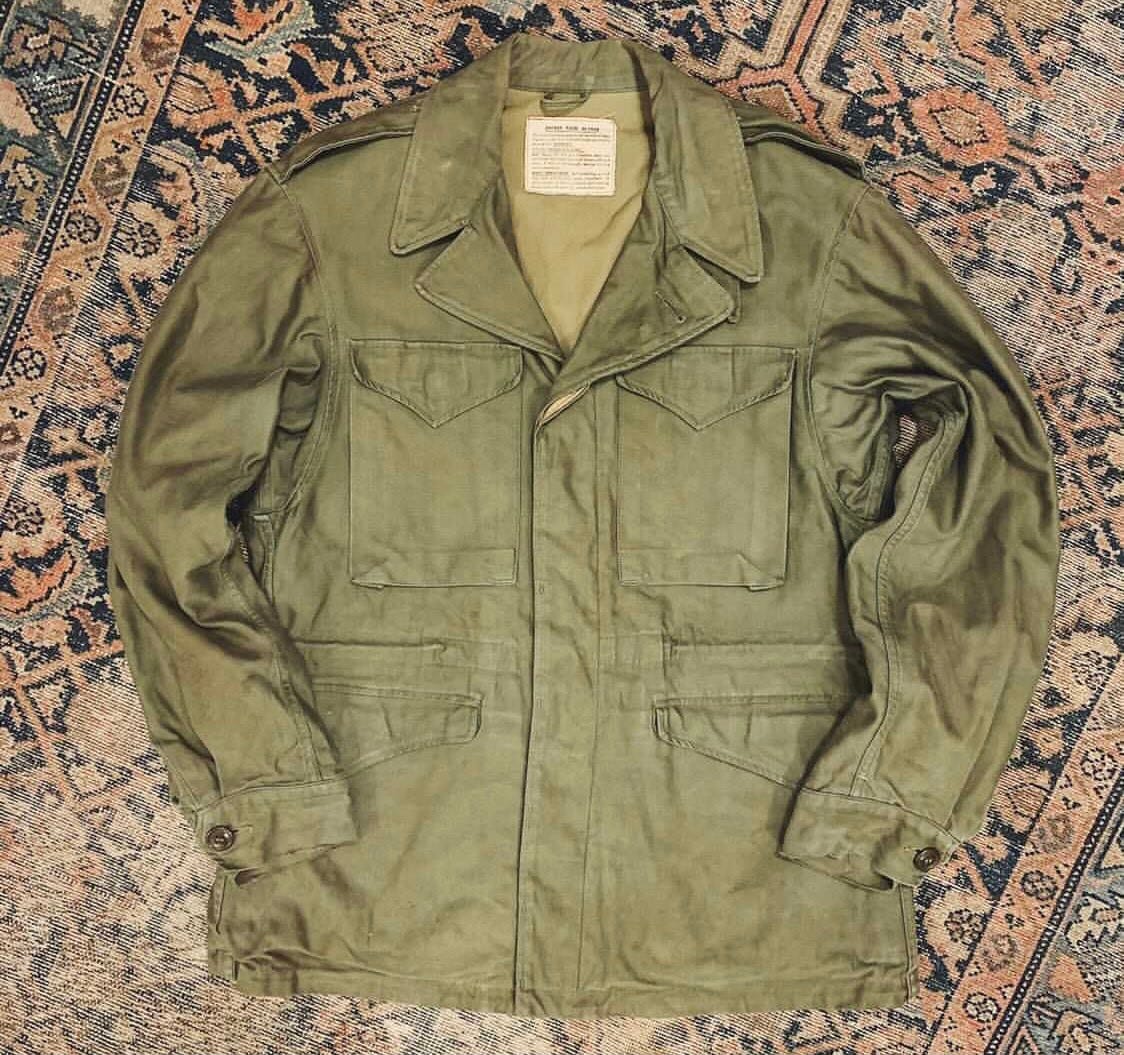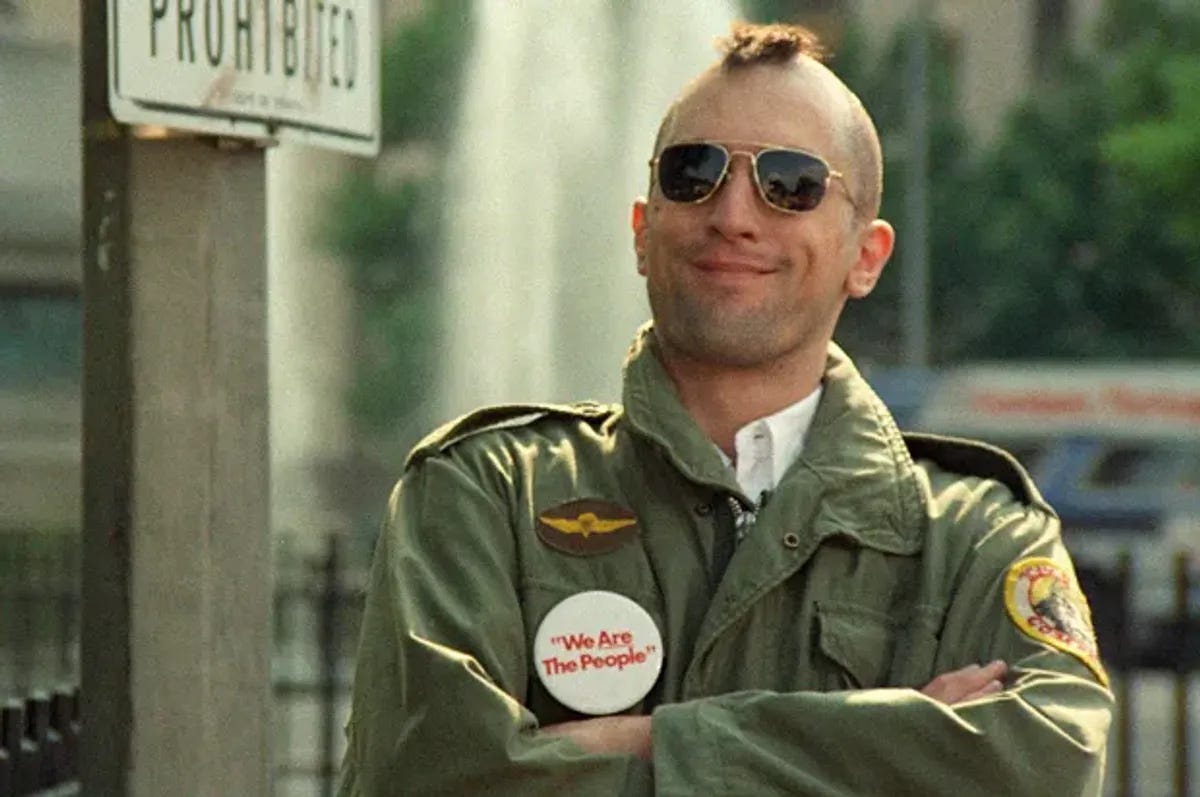In praise of the M-43 Field Jacket
Exploring an overlooked piece of menswear.
Sprezza is a newsletter exploring men’s style. We can talk about clothing, drops, new brands, and products.
Another banger from our good friend, Mark Chou, founder of Bradhurst Ventures and an ongoing contributor to Sprezza. Mark likes to unpack aspects of men’s style that are often overlooked or underappreciated, whether it’s the “made in China” narrative (Mark’s first piece) or a piece of clothing like the M-43 field jacket.
Let’s dive in!
Down the rabbit hole 🕳 🐇
Whenever I develop a new interest, I tend to go deep. My latest rabbit hole this season? Military jackets.
In particular, U.S. Army field jackets from World War II. You know, the jackets that brands like J.Crew, Ralph Lauren, and countless others draw inspiration from, making their own homages (especially the M-65 jacket) every year.
And while the M-65 has become iconic through its Hollywood associations (think Robert De Niro in Taxi Driver or Al Pacino in Serpico), the fact that it’s become ubiquitous is one of the reasons I wanted to find another option.
That’s how I started down the rabbit hole of researching the M-1943 (or M-43 for short), and unlike the M-65 that was adopted by post-Vietnam counterculture, “Younger people suited up post-WWII and never looked at their M-43 jacket again,” according to Brian Davis, founder of Wooden Sleepers, a vintage store. “That’s why an arguably better jacket in the M-43 might be less popular than the M-65.” As I dug into the history of this often-forgotten jacket, though, I learned that it was a seminal piece of clothing not just because of its role in WWII but also because it became the blueprint for the next half-century of field jacket design for the Army.

The perfect fall jacket
Why is the M-43 my underrated jacket pick this fall? Let me count the ways.
Transitional Layering: Fall is a transitional season, and you might see the temperature change 30 degrees or more in a single day. That’s why layering is so important, and believe it or not, we civilians owe a debt of gratitude to the M-43 for popularizing layering technology originally developed for wartime use.
“It looks quite pedestrian to us, but when this came out, this was cutting edge. This was like nothing ever seen before,” explained Charles McFarlane, a longtime field jacket collector who wrote his undergraduate thesis on military field jackets and is now pursuing a master’s degree focusing on the intersection of military and civilian fashion.
The later “Pattern B” versions of the M-43 were designed specifically to better accommodate soldiers’ warming layers, and that makes the jacket perfect for wearing over a sweater or puffy vest.
Versatility: Unlike the M-65, which features a stand-up collar, the M-43 was designed with a collar and lapel that laid flat (although the collar could also be turned up and fully buttoned). The M-43’s collar design enables it to be paired beautifully with not just casual wear but also with tailored clothing, a task that is a bit more difficult with the M-65, which has a much more casual feel.
Durability: The M-43’s fabric is a tightly woven 9 oz. cotton sateen and many 75-year-old+ examples are still in amazing condition, which is a testament to how tough this jacket is. My Barbour Bedale has held up very well over the course of the past decade even with rough handling, but its 6 oz. waxed cotton is sometimes still prone to getting snagged and torn in a way that I’m not worried about with the M-43.
Historical Influence: I’ve already mentioned how the M-43 influenced later field jacket design for the army as well as how it popularized layering technology. But did you know that It was even copied by the military forces of other countries such as the UK, France, the Netherlands, and Denmark? McFarlane spelled it out for me: “The M-43 is the grandfather of all cotton field jackets — all cotton field jackets in the world today can trace their lineage back directly to the M-43.” That also includes Norway, which was still using a slightly modernized version of it as recently as the 1990s. Talk about standing the test of time.
Where to find yours
If you made it this far and are considering buying your own M-43, you have two options – going the vintage route or finding a brand new example. I personally love vintage things that have a story behind them, so finding an original WWII jacket was my aim.
Here are a few places to get started in your hunt:
Wooden Sleepers (Yonkers, NY)
Crowley Vintage (Brooklyn, NY)
Velour (Portland, OR)
Your local Army surplus store!

IMPORTANT NOTE: tagged sizes can be inconsistent in how they fit, in large part because the M-43 jacket was created based on two patterns over the course of its production, the latter of which (Pattern B) was cut significantly larger than its predecessor in order to better accommodate a liner for warmth.
So, always ask for measurements chest, shoulders, sleeve, and back length to ensure a good fit. I’m usually a size 38 but ended up buying a size 34 jacket that fits perfectly.
If going vintage is a bit of a hassle for you, or you just prefer something a bit newer that’s still authentic, you have some options there as well:
The Real McCoy’s: This cult Japanese brand makes perhaps the most high-grade reproductions of vintage militaria (and Americana generally speaking) that you can find – think LVC but for more than just Levi’s. You can also find their M-43 jacket in limited sizes at Standard & Strange ($750) and The Armoury ($810).
Bronson Manufacturing ($130): Bronson makes a variety of classic vintage-inspired American workwear and militaria – not as exacting in its detail and quality as brands like The Real McCoy’s or Buzz Rickson, but also a fair bit less expensive.
At The Front ($125): Rather than focusing on clothing as fashion like the brands mentioned above, At The Front made a name for itself as a supplier of WWII military clothing to historical reenactors and TV and film productions. They’re based in Kentucky and offer a Made in USA range as well.
Best of luck with the hunt, and be sure to tag @spr.ezza if you post on Instagram! Or even better, join Faculty Lounge (Sprezza’s private group chat) and show everyone in the Daily Fits channel. You can join at the end of this piece.


Interested in reading more about field jacket history?
Check out At the Front for a deep dive into all of the details of the M-43, or Heddels for a survey of all US Army field jackets from the M-41 to M-65.
Want to join the Sprezza group chat, Faculty Lounge?
Reply to this email and say let me in!









Thank you for the insight on such a storied jacket! I love military clothing because above all else it’s intended to be functional. It’s also very muted and I find a subtle way to express your style.
Really enjoyed reading this piece about the M-43 Field Jacket! I’ve always admired how functional military-inspired outerwear is, and it never seems to go out of style.
https://www.thewesternoutfitters.com/